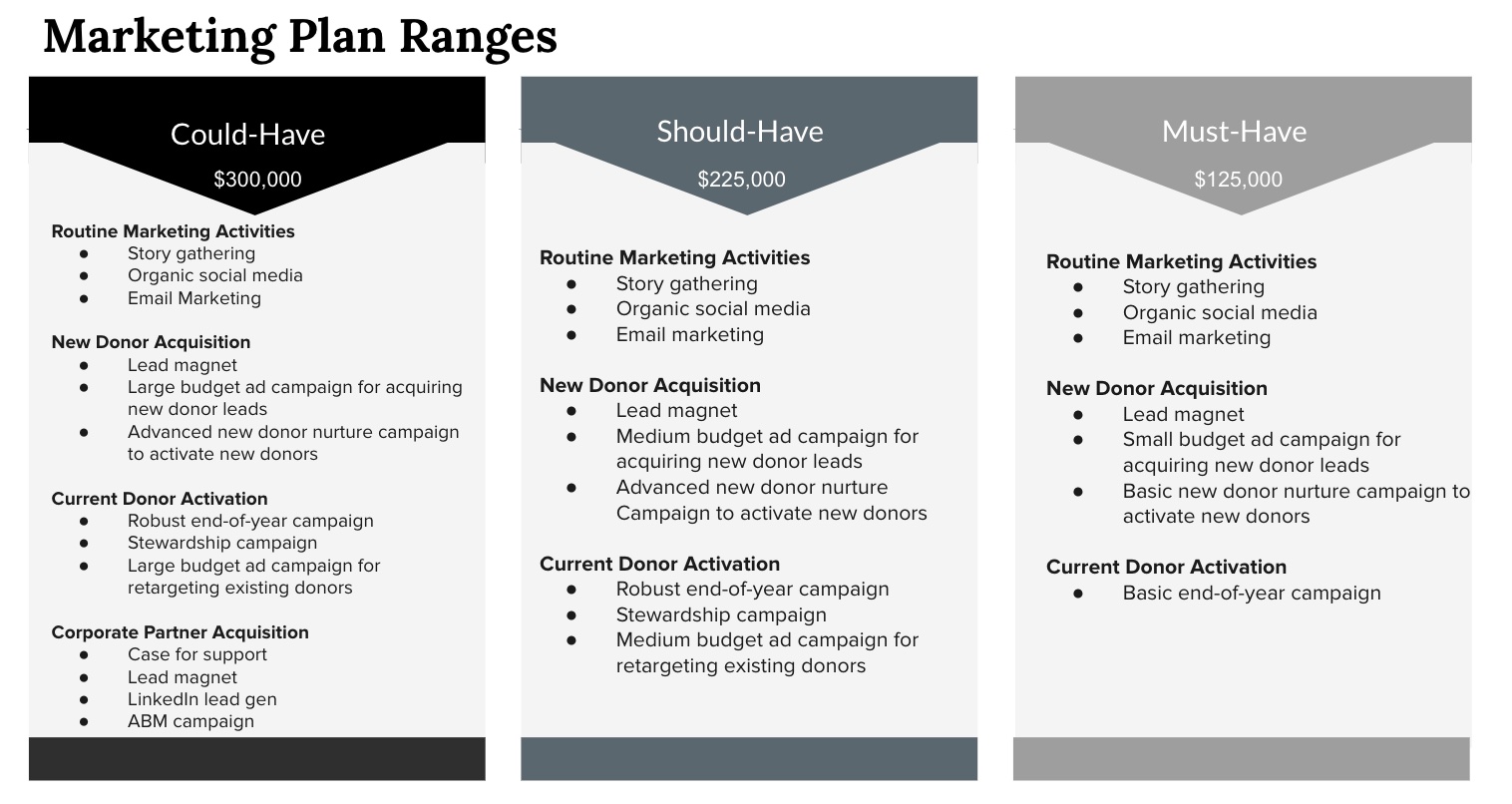Nonprofit marketing planning can be challenging if you don’t have an established budget, and many organizations like to maintain some flexibility in case they happen upon additional funding over the course of a year (wouldn’t that be nice?).
That’s why, at Prosper Strategies, we developed what we call must-have, should-have, could-have nonprofit marketing planning, and in this post, I’ll walk you through what it is, how to do it, and an example for inspiration.
Must-have, should-have, could-have nonprofit marketing planning
Your must-have nonprofit marketing plan provides the foundation for all of your marketing activities and includes everything your organization cannot go without from a marketing perspective.
Your should-have marketing plan includes everything in your must-have marketing plan, but layers in additional tactics and activities that you can leverage, should you secure additional budget.
Your could-have nonprofit marketing plan includes new and exciting initiatives, things you will do if and when you raise more dollars than expected.
So let’s say you plan to spend between $100,000 and $200,000 on your nonprofit’s marketing (excluding your team’s salaries). In this case, your must-have budget would be around $100,000, your should-have budget would be around $150,000 and your could-have budget would be around $200,000. You’ll use these ranges to brainstorm which tactics fall into each of your marketing plans.
Identifying your nonprofit marketing plan budget ranges
To be clear, must-have, should-have, could-have nonprofit marketing planning isn’t pie in the sky and should be grounded in the realities of your nonprofit and its budget. So to start out, if your nonprofit doesn’t have an existing marketing budget, you need to set ranges. Most nonprofits spend between 5 and 15 percent of their total budget on marketing.
However, rather than just using a percentage of overall budget, we recommend using adaptive, goal-based budgeting. This approach bases your nonprofit’s marketing budget not on a percentage allocation or on past performance, but on marketing’s expected (and measurable) impact on your organization’s broader strategic goals.
The beauty of adaptive, goal-based budgeting is that it’s totally accountable. Each dollar spent on nonprofit marketing, communications and fundraising has a meaningful return on your organization’s goals, and budgets are constantly optimized so that the tactics and initiatives with the highest returns take priority. This allows marketing to occupy the growth driver role it deserves and truly further your organization’s impact rather than simply supporting it.
Must-have, should-have, could-have nonprofit marketing planning lends itself well to the flexibility of adaptive, goal-based budgeting.
Select your nonprofit marketing tactics
Once you have budget ranges established for your must-have, should-have and could-have nonprofit marketing plans, you’ll (at the very least), outline the marketing activities and tactics you’ll deploy for each corresponding plan.
So let’s take a look at the example below for inspiration.
This nonprofit has a must-have marketing budget of $125,000; a should-have marketing budget of $225,000 and a could-have marketing budget of $300,000.
In their must-have marketing plan, they are going to include routine marketing activities, like story gathering, social media and email marketing. They are also planning to conduct a lead generation campaign, where they will use a small ad budget to promote content for download in exchange for email addresses to build their database. They will develop a basic new donor email campaign. Finally, they will run a basic, end-of-year campaign.
Should they secure more budget (which they are fairly certain they will), they will focus on their should-have marketing activities with a budget of $225,000. This plan includes the activities in their must-have marketing plan, but increases their ad spend for the lead generation campaign. They also plan to do a more advanced new donor email campaign. In the should-have marketing plan, they will beef up their end-of-year campaign, layer in a stewardship campaign and begin running online ads to retarget their existing donors.
However, to ensure they are always thinking ahead, they have also developed a could-have marketing plan with a budget of $300,000, ready to go if that major donation lands on their doorstep (MacKenzie Scott, I’m talking about you). In the could-have marketing plan, they are doing everything they would do in the should-have marketing plan, but they are again increasing their ad spend for the lead generation campaign and leaning into email activities that will help them activate new donors. They are also planning for a robust end-of-year campaign, a stewardship campaign and a large ad budget to retarget existing donors. In this nonprofit marketing plan, they are adding in tactics to support corporate partner acquisition, including the development of a case for support and an account-based marketing campaign.
Notice how the should-have plan builds off the must-have plan and the could-have plan builds off the should-have plan. This method of nonprofit marketing planning ensures that the thinking your nonprofit is doing about marketing isn’t overly limited by budget. You can also use it to plan for different scenarios, should more funding become available (or if you want to seek a grant to support more robust nonprofit marketing efforts).

